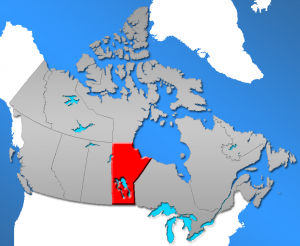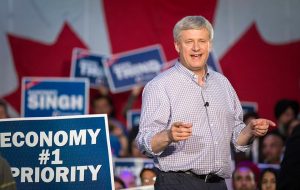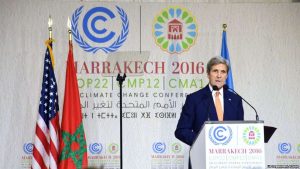On the penultimate night of the COP, I went out to a farewell dinner with my client, the Climate Registry. There, I got the chance to speak with Neil Cunningham, Director of Energy and Climate Change for the Government of Manitoba, a province bordering North Dakota and Minnesota.

Manitoba on a map of Canada. Image from: http://www.lahistoriaconmapas.com/atlas/canada-maps/manitoba-canada-map.htm
The province, as I soon learned, generates the majority of its energy from the province’s abundant supply of water. In fact, in the province, nearly 80 percent of electricity is produced via hydroelectric generating stations on the Nelson River in northern Manitoba.[1] The excess energy that this province produces is then sold in several other Canadian provinces and in the mid-western United States.
While talking to Neil Cunningham, it became clear that for Manitoba, hydropower just made sense—the province has ample rivers in which a generating station can be placed and the energy produced is both clean and economical. Last January, Manitoba and Alberta signed a bilateral Memorandum of Understanding on Renewable Energy and Climate Change Initiatives, putting pen to the provinces’ plans to prioritize improving electrical grid integration to facilitate the sale of hydroelectricity from east to west.[2] As we, as a global society, look to diversity our energy portfolio, hydroelectric will likely be an important part of the mix in towns that, like Manitoba, are situated near rivers.
Now, the majority of the conversations I’ve had in the past two week have devolved, in one way or another, into conversations regarding American politics. And as I was speaking with Neil, and by this time a small group of other subnational climate change officials including several at the California Department of State, the conversation, once again, took that familiar turn. However, unlike in previous conversations, I got to hear a Canadian’s perspective—and this perspective gave me optimism for the next four years of American climate change policy.
Before the beloved Canadian Prime Minister Trudeau, there was Stephen Harper (Prime Minister from 2009 to 2015).

Former Canadian Prime Minister Stephen Harper. Photo from: http://www.vice.com/en_ca/read/a-political-eulogy-for-stephen-harper
Conservative and with a soft spot for tar sands expansion[3], Harper was largely disinterested in addressing climate change. And in the face of a lagging central government, subnational actors came to the forefront with some of Canada’s most ambitious climate change policies.
When Canada’s federal government was slow to develop a greenhouse monitoring and emissions reduction plan, several provinces established sizeable programs within their respective territories. British Columbia, Manitoba, Ontario and Quebec, for example, joined the Western Climate Initiative to support the implementation of state and provincial greenhouse gas emissions trading programs.[4] Then in 2014, Quebec linked its own cap-and-trade system with California under the Western Climate Initiative.[5] Similarly, in 2007, the Specified Gas Emitters Regulation in Alberta put a price on carbon in the province, and a year later, Alberta released its Climate Change Action Plan.[6]

Ontario, which is Canada’s most populated province, released its climate action plan in 2007. Photo from: http://goista.com/ontario-the-most-populous-province-of-canada/
For its part, Ontario, which is Canada’s most populated province[7], released its climate action plan in 2007.[8] The plan established three primary targets: a six percent reduction in emissions by 2014, a 15 percent reduction by 2020 and an 80 percent reduction by 2050. The government also committed to reporting annually on the actions it is taking to reduce emissions and adapt to climate change.[9]
While we don’t know what America’s climate change action will look like in the following four years, examples from Canada illustrate that weak Federal government policies doesn’t mean stagnation. Rather, it means that progress must be made creatively and through a patchwork of subnational action. This election may not create climate progress, but it can create room where subnational actors can flourish and forge ahead.
References
[1] ManitobaHydro. (n.d.). Producing electricity. Retrieved November 25, 2016, from https://www.hydro.mb.ca/corporate/facilities/gi_producing_electricity.shtml
[2] Government of Alberta. (2016, January 8). Alberta and Manitoba sign MOU on shared energy and climate change priorities: Selinger, Notley. Retrieved November 25, 2016, from http://www.alberta.ca/release.cfm?xID=390705C45ADB9-D76C-6E1B-9EC6271FFF650EF6
[3] Barlow, M., & Klein, N. (2015, October 16). Stephen Harper’s politics put Canada to shame: Don’t be distracted by them | Naomi Klein and Maude Barlow. Retrieved November 25, 2016, from https://www.theguardian.com/commentisfree/2015/oct/16/stephen-harper-canada-carbon-climate-change
[4] Western Climate Initiative. (n.d.). Western Climate Initiative. Retrieved November 25, 2016, from http://www.westernclimateinitiative.org/climate-action-plans
[5] Office of the Premier. (2016, August 31). Ontario Working with Québec and Mexico to Advance Carbon Markets. Retrieved November 25, 2016, from https://news.ontario.ca/opo/en/2016/08/ontario-working-with-quebec-and-mexico-to-advance-carbon-markets.html
[6] Specified Gas Emitters Regulation. (2007). Climate Change and Emissions Management Act. Retrieved November 25, 2016, from http://www.qp.alberta.ca/1266.cfm?page=2007_139.cfm&leg_type
[7] Government of Canada. (2016). Population by year, by province and territory (Number). Retrieved November 25, 2016, from http://www.statcan.gc.ca/tables-tableaux/sum-som/l01/cst01/demo02a-eng.htm
[8] Government of Ontario. (2007, August). Go Green: Ontario’s Action Plan on Climate Change. Retrieved November 25, 2016, from http://www.climateontario.ca/doc/workshop/2011LakeSimcoe/Ontarios%20Go%20Green%20Action%20Plan%20on%20Climate%20Change.pdf
[9] Government of Ontario. (2007, August). Go Green: Ontario’s Action Plan on Climate Change. Retrieved November 25, 2016, from http://www.climateontario.ca/doc/workshop/2011LakeSimcoe/Ontarios%20Go%20Green%20Action%20Plan%20on%20Climate%20Change.pdf




